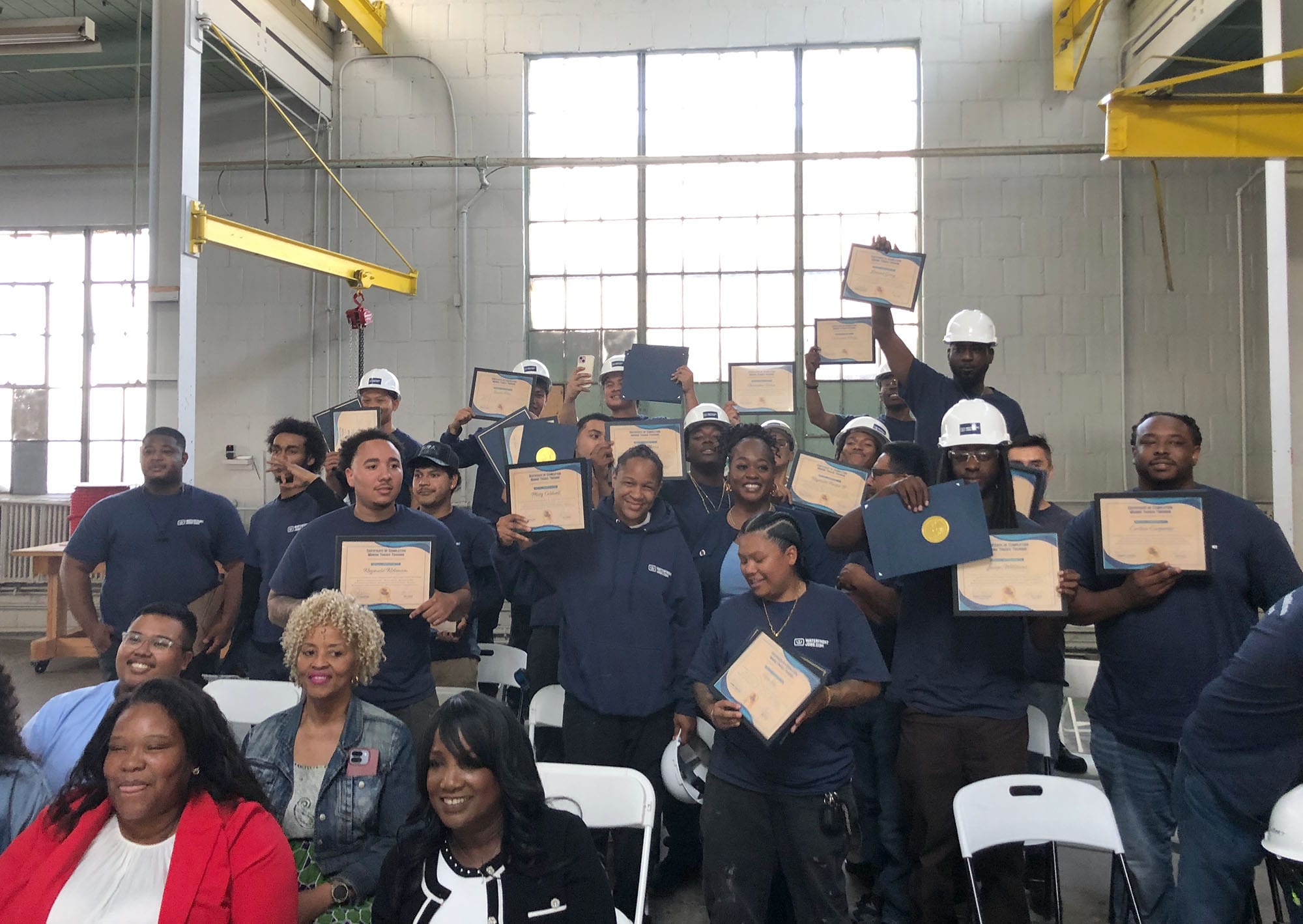
VALLEJO – Twenty-three students graduated from the Waterfront Jobs training program at their student workshop on Mare Island Friday after spending the past 10 weeks learning trade skills for in-demand positions such as welders, mechanics and industrial painters.
“It’s a good foundation to see the trades in the maritime jobs,” said graduate Chris Dolan from Pinole, who hopes to work as a welder at Bay Ship and Yacht. “In this industry you have the best people.”
The training program is run by the Working Waterfront Coalition, a collaboration of industry employers seeking to create a pipeline from the academy directly into jobs. It was started last year by Bobby Winston, one of the founding members of the Bay Area’s ferry service, “who saw an industry need for skilled laborers but no supply,” said Sal Vaca, the coalition’s project director.
The coalition consists of various local maritime employers such as shipyards and tugboat and ferry boat companies, including the local Mare Island Dry Dock and Bay Ship & Yacht Co. from Alameda. The training program works in partnership with workforce development boards across the Bay Area, including Contra Costa, San Francisco, Alameda and Solano counties, who are in charge of recruitment and securing funding through California Workforce Development grants.
Students learned technical skills such as tying knots, rigging, pipe fitting, diesel motor mechanics, and stick welding. They also visited shipyards, welding shops, and potential employers, in addition to spending class time learning professional development skills such as interviewing and resume writing.
One previously graduated student, 19-year-old Shelton Brooks of Vallejo, now works as a rigger on the National Park Service ship the Balclutha, which is now docked on Mare Island. Brooks said he earns good money, plans to work as a rigger full time, and now would like to learn to sail. He learned the basic skills of his trade during the program tying knots and rigging.
Chuck Carpenter, a teacher and outreach specialist at the coalition, said the biggest impact isn’t just the skills students learn, but the personal growth that happens when people are given tools and shown they can build something with their own hands. “The amount people change is amazing,” Carpenter said. “They dial down, they focus, they start seeing they have a future.”
The coalition also partners with various community partners and unions. The Lao Family Community Development group from Oakland placed four Burmese refugees, who were given the nickname “the blues crew,” into the training program.
“The four had never welded before,” said Carpenter. “Now Bay Ship will hire all four.”
Students receive a $1,200 stipend, are given a toolkit, boots, transportation assistance and anything related to hiring costs. There are no eligibility requirements.
“If it wasn’t for this program I would have never experienced any of this,” said graduate Ismael Rivas from East Oakland, who hopes to go work with the Pile Drivers Local 34 union.
The graduation’s guest of honor was California Superintendent of Public Instruction Tony Thurmond, who said “at a time when people struggle to make ends meet, we are able to send people into an industry where there are more jobs than people.”
Nationally, the shipbuilding industry is hoping to make a comeback, with various bills to bolster the industry gaining traction in Congress. The maritime sector offers 2.6 million jobs nationally and the program publicizes that students could immediately start earning around $50,000 per year and work up to six-figure salaries.
U.S. Rep. John Garamendi and Vallejo Mayor Andrea Sorce are also supporters of the program and bringing back Maritime jobs back to Vallejo. “I definitely see opportunity for us to grow our maritime industry in Vallejo and further leverage and engage our existing stakeholders such as Cal Maritime, Mare Island Dry Dock, and the Working Waterfront Coalition,” Sorce said. “We are in active conversations.”
This last cohort did not feature as many students from Vallejo or Solano County. Cynthia Seals-Roper from the Solano County Development Board said that while the program’s first cohort, which graduated in November, were mostly Vallejoans, recruitment fell off because the county received less workforce development funding this year. She said that she absolutely wants to see the number of locals in the program rise again and is working to secure more grants.
The coalition hopes to graduate three cohorts per year with 20 to 30 students each, while still being able to provide wrap-around services, to both bolster the maritime industry and provide opportunities to people who need it.
Stephen Brown, who graduated in the program’s first cohort and now works at San Francisco Maritime Exchange, said it helped him get a foothold in the industry. “I’m just a regular guy with an interest in welding and desperately needed employment,” he said.

